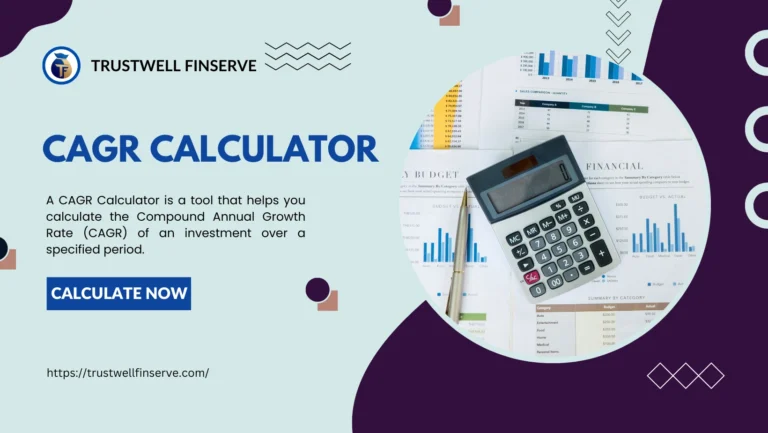When it comes to evaluating how your investments have performed over time, CAGR (Compound Annual Growth Rate) offers a clear and standardized measure. It helps you understand the average annual return on your investment, assuming the profits were reinvested every year.
With our CAGR Calculator, you can easily estimate the annualized return of your investments—whether it’s mutual funds, stocks, or any long-term asset.
CAGR Calculator
What is CAGR (Compound Annual Growth Rate)?
CAGR is the rate at which an investment would have grown if it had increased at the same rate every year, with profits reinvested at the end of each period. It provides a smoothed average of returns over time and eliminates the effects of market Volatility.
Why Use a CAGR Calculator?
A CAGR Calculator simplifies the process of understanding how much your investment has grown annually over a specific period. Instead of manually using complex formulas, the calculator delivers quick and accurate results.
Key Benefits:
- Simple & Fast Calculation
- Works for different asset types (mutual funds, stocks, FDs, etc.)
- Helps compare multiple investments
- Useful for long-term financial planning
How Does the CAGR Calculator Work?
To calculate CAGR, you need:
- Initial Value (Start Value)
- Final Value (End Value)
- Investment Duration (in years)
CAGR Formula:
CAGR = [(Final Value/Initial Value) ^ (1/N)]-1
Where n = Number of years
Example:
Suppose you invested ₹1,00,000 in a Mutual Fund, and after 5 years, the value becomes ₹1,80,000.
CAGR = [(1,80,000/1,00,000) ^ (1/5)]-1
Your investment grew at an average annual rate of 12.47%.
How to Use Our Online CAGR Calculator?
- Enter your Initial Investment Amount
- Enter the Final Value of your investment
- Enter the Investment Duration (in years or years + months)
- Click Calculate CAGR
- View your annualized return instantly
The calculator also displays the Total Return and growth multiplier, providing a complete picture of your investment’s performance.
Advantages of Using a CAGR Calculator
- Time-saving: Eliminates manual calculations
- Accurate Results: Uses a tested mathematical model
- Clear Comparison: Evaluate multiple investment options on the same scale
- Strategic Planning: Understand long-term growth potential
When Should You Use a CAGR Calculator?
- To compare different investment products
- To analyze your Portfolio’s historical performance
- When reviewing mutual funds, stock investments, or even fixed deposits
- For financial planning and retirement strategy
CAGR vs. XIRR vs. IRR – What’s the Difference?
| Metric | Best For | Considers Cash Flow Timing? | Use Case |
|---|---|---|---|
| CAGR | Simple investment growth | ❌ No | Ideal for one-time investments over time |
| XIRR | Irregular cash flows (e.g., SIPs) | ✅ Yes | Best for mutual fund SIPs |
| IRR | Custom cash flows & multiple periods | ✅ Yes | Advanced investment evaluation |
🔗 Also Read our post on SEBI Categorization Of Mutual Funds In India
Conclusion
CAGR is a fundamental metric every investor should know. It offers a realistic view of your investment performance and is an essential part of any financial analysis toolkit. With our CAGR Calculator, you can calculate, plan, and grow your Wealth smarter and make smarter, data-driven decisions and understand returns.
Disclaimer: The content on this blog is intended solely for educational purposes. The results produced by the calculator or calculators are merely indicative and intended for informational reasons.
Under no circumstances should these calculators be regarded as financial, Investment or professional advice from Trustwell Finserve (“TWF”), nor are they intended to offer users certified results from TWF or to act as an obligation, guarantee, warranty, undertaking, or commitment. They are only instruments to assist users in analyzing different illustrative situations according to the information they enter. These calculators are used at the user’s own risk, and TWF assumes no liability for any mistakes, inaccuracies, or results that may result from using them.
